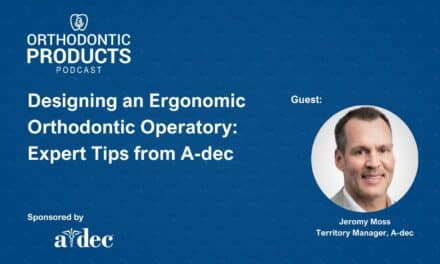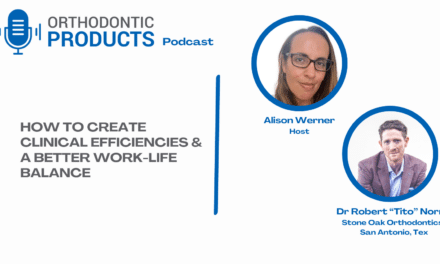In this episode of the Orthodontic Products Podcast, we explore the evolving role of orthodontists in treating airway issues, particularly upper airway obstruction and sleep-disordered breathing. Robert “Tito” Norris, DDS, an orthodontist from San Antonio, has been integrating airway-friendly orthodontics into his practice for years. He discusses how this approach not only helps improve aesthetics but can also significantly impact overall patient health, from cognitive development to life expectancy.
Recognizing Airway Issues in Orthodontics
Norris delves into the clinical signs that may indicate airway-related issues, such as open bites, high caries rates, and anterior wear on teeth. He explains that these symptoms often go hand-in-hand with underlying sleep issues, such as snoring or sleep apnea, particularly in children and adults with nasal obstructions. The use of CBCT imaging and sleep questionnaires, like the Chervin Pediatric Sleep Questionnaire and SNOT 22, allows orthodontists to identify and assess airway problems early, enabling timely intervention. By leveraging these diagnostic tools, orthodontists can play a crucial role in diagnosing and managing sleep-disordered breathing before it escalates into more serious conditions.
Treatment Options and Collaboration with Specialists
Norris also highlights several treatment options, including the use of MARPE (Mini-Implant Assisted Rapid Palatal Expansion), which he has found to provide superior skeletal expansion with minimal dental tipping. He explains how early intervention in children can prevent the progression of sleep apnea and other airway issues, and why treating these problems sooner rather than later can have long-lasting health benefits. Moreover, Norris emphasizes the importance of collaboration with ENT and sleep specialists to provide comprehensive care for patients suffering from airway obstructions and sleep-related breathing disorders.
Key Takeaways:
- Airway-friendly orthodontics can significantly improve a patient’s overall health, particularly by addressing sleep-disordered breathing.
- Early intervention using diagnostic tools like CBCT and sleep questionnaires can help orthodontists identify airway issues before they escalate.
- Collaborative care with ENTs and sleep specialists enhances patient outcomes for those with airway obstruction and sleep apnea.
Resources:
Dr Norris’ three-part article series in Orthodontic Products:
Podcast Transcript
Alison Werner (00:04)
Hello and welcome to the Orthodontic products podcast. I’m your host, Alison Werner. In this episode, we explore what can be a critical yet often underperform aspect of orthodontic care, airway friendly orthodontics and its role in treating upper airway obstruction and sleep disorder breathing. We’re going to talk about how the orthodontist role can go beyond providing a beautiful smile and really impact a patient’s overall health and life expectancy. My guest is Dr. Tito Norris, an orthodontist who has made the treatment of upper airway obstruction and sleep disorder breathing a part of his practice.
You might have seen his three part series in recent issues of orthodontic products and online where he talks about integrating this aspect of care into your practice and shares clinical cases. Dr. Norris is in private practice in San Antonio and lectures both nationally and internationally. He also holds several patents and trademarks and is the inventor of the Norris Passive Self-Legating Bracket System. We’ll discuss how orthodontists can recognize airway related problems, utilize CBCT imaging and sleep questionnaires, and collaborate with ENT and sleep specialists for comprehensive patient care.
Plus, Dr. Norris will share treatment approaches, including the role of the MARPE in treatment and recommend resources to help you get started and go deeper with this treatment modality. Here’s our conversation.
Alison Werner (01:13)
Dr. Norris, thank you for joining me.
Tito Norris (01:15)
It’s my pleasure, Alison.
Alison Werner (01:17)
⁓
great. So let’s get started. What inspired you to incorporate airway friendly orthodontics and sleep disorder breathing treatment into your practice?
Tito Norris (01:25)
Well, it’s actually been a goal of mine for many years, honestly. The struggle that I had was actually finding the supportive team to work with. And in particular, the element of that team that was lacking was an ENT who really got it, who really understood that.
Alison Werner (01:37)
Hmm.
Mm.
Tito Norris (01:50)
know, tonsils, yes, they might eventually shrink, but by that time the damage is done. And, you know, if a kid can’t breathe, he’s really suffering and it’s not getting great sleep. It’s going to affect their performance at school, their performance on the soccer field. You know, what you learned that day, it doesn’t get up upload to the hard drive. And so it affects them, you know, neurocognitively in terms of their development. And so finally, you know,
Alison Werner (01:56)
Mm-hmm.
Tito Norris (02:20)
We started educating some ENTs and we got a couple of new ENTs in town and so that has really changed things dramatically. So we’ve kind of been working hand hand now with some, I’m going to say enlightened ENTs who get it and who are willing to take our referrals and actually do something about it and not just treat patients based on what insurance will pay or will not pay and so forth.
Alison Werner (02:36)
Yeah.
Okay.
Tito Norris (02:49)
It
was just quite frankly very frustrating. mean we’ve been doing some airway friendly treatments for many many years. However, also I have to say that simply technology has changed, right? And we’ve got tools that are available today that we didn’t have before.
Alison Werner (02:59)
Mm-hmm.
Okay.
Yeah.
Tito Norris (03:11)
dads,
MARPEs, those kinds of things. So those have all made big changes. And quite frankly, I was influenced by Dr. Jeff Rouse, who is a prosthodontist. And he’s actually here in San Antonio. He speaks at the Spear Center. And I treated his son. Dr. Rouse is a very airway-centric prosthodontist.
Alison Werner (03:20)
Mm-hmm.
Mm-hmm.
Mm-hmm.
Okay.
Tito Norris (03:41)
who has absolutely astounding command of the literature in this area. And he has really enlightened me as to a number of things that we can do to help patients in this regard.
Alison Werner (03:55)
Okay,
so what are the most common signs and symptoms you look for when evaluating an adolescent patient and then an adult patient? Because I know you also do treat adults for airway obstruction or sleep disorder breathing.
Tito Norris (04:07)
We do. Roughly almost half our patients are adults. But whether it’s a child or adult, I mean, we’re looking for things such as a high caries rate. I mean, that can occur due to mouth breathing often. Open bites, anterior open bite, lateral open bites, which is often an indication of a tongue.
know, position that’s not right. And then we ask the question, well, why is the tongue position not right? Right? It’s very often, you know, their tongue tied or maybe it was, they can lead to microglossia. Maybe they’re pushing the tongue forward because they’ve got large tonsils. That’s often the case. And they’re just trying to get more air. And so a lot of your open-bite cases are actually airway cases. Things such as interior spacing.
patients who have a narrow maxilla or B-shaped palate, postural cross bites, having a deep, angle, a short upper lip can be an indication that the patient has nasal obstruction and you get some atrophy of the leverage of the labia muscles in the upper lip and so the upper lip tends to shorten. It has a very specific pattern. It’s actually short at the philtrum, but not so much at the commissure. So you get this sort of gull wing looking shape to the upper lip, which also often is like pathinomy.
Alison Werner (05:13)
Mm.
okay.
Tito Norris (05:24)
for patients who got nasal obstruction and mouth breathing. And they were also looking at such as vertical maxillary excess, VME, and then even patients who have anterior wear on their teeth, because these patients will function out here in protrusion because they’re trying to get more air, and especially during para-functional times, maybe nocturnal bruxism, but they’re doing that in protrusion. And so you’ll see this anterior wear.
Alison Werner (05:25)
Mm.
Mm-hmm. Mm-hmm.
Tito Norris (05:54)
pattern and so all of these things are essentially canaries in the coal mine that we as dentists and orthodontists can see these things and can recognize these things and get the patient’s early treatment before some of the systemic issues start to pop up and those systemic things are what an ENT may or may not recognize but once again if you have your radar up you can start asking the appropriate questions.
Alison Werner (06:00)
Right.
Tito Norris (06:24)
and correlate some of these dental signs and symptoms with some the systemic ones.
Alison Werner (06:29)
Yeah.
So talk to me about how sleep questionnaires. So I know in your practice you use the Chervin Pediatric Sleep Questionnaire or CPSQ and then SNOT 22 to help for adults and help in identifying potential airway issues. So talk to me about those questionnaires and why those were right for your practice.
Tito Norris (06:42)
That’s great.
Sure.
Well, first of all, there’s a lot of different questionnaires out there. These were the two most validated instruments that were out there. And by that, what I mean is that, you know, in multiple studies, they’ve been shown to have a very high correlation with symptoms. And so, not just symptoms, but the questionnaire has a high correlation to the actual issues, is what I’m saying. And this has been tested over and over again.
multiple, multiple times in both sleep medicine and ENT literature. And so for that reason, number one, they’re the most reliable, the most tested.
tests out there. Okay, so that was was reason number one. And then reason number two, it’s just a fairly easy thing to do as part of your normal medical history to go and just have them fill out one more little form there and it’s green everybody and it’s amazingly surprising how many times you’ll pick up things that you might not have picked up just simply because you asked the question.
Alison Werner (08:00)
So how has CBCT imaging changed the way you assess and diagnose airway issues in orthodontic patients? Because I know that’s a part of your diagnostic protocol.
Tito Norris (08:09)
Absolutely,
quite frankly, just, wow. I mean, I’ve been doing this for 30 years and I know that I practiced without a CBCT for many years, but today I just can’t even imagine going back. I think I’ve been using CBCT for probably about half my practice, like probably about the past 15 years I’ve had one.
Alison Werner (08:16)
Yeah.
Yeah.
Tito Norris (08:32)
But today we just use it so much, just for looking at roots and looking at the width of jaw bones and we’re looking at deviated septum. We’re looking at things like root angulations.
upper jaw versus the lower jaw bone. can do a minimal axial airway analysis and that’s another tool that we combine with our questionnaire with symptoms. So there’s just there’s so many things that we get from the CBCT but you have to take it to kind of take that with a little bit of grain of salt because it’s not always
There’s not always a direct correlation is what I’m saying. You’ve got a static image of a dynamic process, right? And even if the CBCT is taken well with a patient with proper posture and swallowing and all these kinds of things, there is still very few people I know who sleep standing up, right? And so, we don’t have, number one, we don’t have a…
Alison Werner (09:15)
Okay.
Right. Yeah.
Tito Norris (09:38)
CBCT that takes the records in the same sleep, the same position that we’re sleeping in. And number two, it’s a static imaging and we all know that breathing is a dynamic process. that those two, those right now today are the two major limitations of cone beam
Alison Werner (10:01)
So what specific anatomical structures do you examine to kind of determine if a patient has an airway obstruction?
Tito Norris (10:08)
Yeah. Well, I mean, gosh, there’s a lot of things. OK, one of the things though, we’re looking at the maxillary position and we’re seeing where the maxillary incisor falls in relationship to vertical from soft tissue nasion. OK, so that’s kind of like the first place that we look. OK, where is that maxilla?
Alison Werner (10:13)
hahaha
Tito Norris (10:33)
And if it’s back, it’s retronathic, then start to, know, kind of spidey sense starts to pop up there and see, okay, well, there’s a very maxillary deficient. And very often it’s the thing. we look at a Ceph, we look and see, you know, hey, do they have swollen adenoids? We’re looking, you know, just at the, even at the airway on Ceph, can even see the tonsils there. We’re going to the cone beam CT, we’re checking on those same structures, but now we can look
at
those things in 3D. We’re looking in the mouth, we’re looking for posterior cross bites, we’re looking for, you like I said, a narrow maxilla, we’re looking for retronathic either maxilla or mandible or both. And, you know, things such as wear on the teeth and all the things that we just kind of talked about, know, narrow, V-shaped maxilla, high mandible flat angle, short upper lips, you know, all of those things are signs and symptoms of airway issues.
Alison Werner (11:21)
Yeah.
Okay, all right, so we’ve talked about kind of the evaluation and diagnostic. So let’s talk about treatment approaches. How does Maxillary, yeah, yeah, go ahead.
Tito Norris (11:37)
Before we go there,
we do have within our practice, we actually have some home sleep studies that we check out to patients. these are in our practice, we use the watch pat.
Alison Werner (11:44)
Okay, I was gonna ask you about that. Okay.
Tito Norris (11:51)
which is a very robust machine. In fact, it is the same machine that the VA hospitals all over the United States use to diagnose sleep apnea on their patients. Now, because I’m not a sleep physician, I can’t make a sleep apnea diagnosis, but I can certainly read a watch pat legally and tell the patient that there are some signs that you might have sleep apnea and therefore, and that usually gets their attention. And I just don’t want there to be any,
Alison Werner (11:59)
Thank you.
Yeah.
Right.
Mm-hmm.
Yeah.
Tito Norris (12:20)
Any barriers for them, right? So we give this to them complimentary. They check it out like a library book, gives a credit card. And, you know, we, take care of as a loss leader, we can, kind of take care of the disposables and it’s a few bucks or something like that. So that’s another piece to the puzzle diagnostically that, really helps us get the attention of the patient. Now that’s their, uh, the, excuse me, the watch pat is, it’s great for adults, but it’s not so great for kids. But so we can, we can just send them home with a simple pulse ox.
Alison Werner (12:21)
Mm-hmm.
Yeah.
Mm.
Tito Norris (12:50)
and we can look at things like that. And if we really have an high index of suspicion, can, you know, of course try to get them seen by a sleep lab and get that sleep study done.
Alison Werner (12:50)
Okay.
Okay, so once you have the this that that data are you then sending them out to a sleep physician or an ENT or how are you approaching it from there before treatment? Okay.
Tito Norris (13:13)
Yes, yes, and
so Let’s just take a for instance. I saw a patient the other day who you know Came to me for malocclusion and I suspected that he had sleep apnea and his life his wife was kind like well You know maybe and he was like I don’t know and so we sent him on the home sleep status test and it came back
Alison Werner (13:31)
You
Tito Norris (13:37)
very positive as severe sleep apnea. And so, you know, I’m like, okay, listen, you know, run, don’t walk. you know, let’s go get you into the care of a sleep physician and, you know, get a sleep test. You’ll get a CPAP machine. And if you love it, fantastic. And if you don’t love it, come back and see me because you would be a candidate for MMA, Maxillomandibular advancement. Because somebody who’s got a, you know, his AHI was 52, right? So 52 times an
Alison Werner (13:44)
Mm-hmm.
Mm-hmm.
Okay, yeah.
Tito Norris (14:07)
he stops breathing. Okay. So basically every minute he stops breathing. Right. And so that’s pretty bad.
Alison Werner (14:08)
Okay. Yeah.
Yeah.
Okay, so once they do come back to you, let’s talk about treatment approaches. So what are the key options you’re looking at with let’s start with adolescent patients? What are you doing there?
Tito Norris (14:22)
Yep.
Sure. Sure. So on adolescent patients…
Basically, we’re making sure that they got a clear airway in terms of a patent nasal airway. And so the ENT is helping us with that. And then we’re also just doing expansion because as we know that the, you know, the roof of the mouth is the floor of the nose. So when you expand, you’re not only creating more interoral volume, but you’re also increasing your nasal breathing volume. And then you get an exponential benefit due to Bernoulli’s principle.
So if you expand, you a 1x, you get like a 3x improvement in nasal breathing.
And so that’s the main thing. And now the other aspect of it is expansion on anybody is going to simply by creating a larger oral cavity. Think about the tongue is like a water balloon. Okay. So part of that tongue has to exist in the mouth and then the root or base of the tongue actually exists down in the pharynx and the breathing tube. So imagine that water balloon. And if you squeeze on that pharyngeal part and make it
Alison Werner (15:35)
Yeah.
Tito Norris (15:44)
smaller or in other words, if you make the oral cavity bigger and that grows, well then the water is going to go into there, right? So it makes the pharyngeal aspect smaller. Conversely, if you have a small oral cavity, then more of that tongue has to live in the pharynx. So simply by expanding and having a larger oral cavity, more of the tongue can live in the oral cavity, the less of the tongue has to live in the pharynx and that opens up the airway.
Alison Werner (16:07)
Yeah.
Okay. And then for adults, what do you opt opting for there?
Tito Norris (16:14)
Yeah, and so with adults it really kind of depends on a number of factors. First of all, how severe are they? Are we talking mild, moderate, or severe? Personally, I’m not a big fan of oral, mandibular advancement appliances because they all change your occlusion. Unless you’re class two, it’s not great. And then you’re married to an appliance for the rest of your life.
Alison Werner (16:36)
Mm-hmm.
Okay.
Tito Norris (16:39)
So
I’d much rather fix the physiology, fix the structures. So what does that look like? Well, in many cases, that looks like some expansion. So sometimes that’s dentoalveolar expansion. And sometimes that means that we’ve got to add some bone using a procedure called SFOT or PAOO or also called Wilckodontics, right, to simply add some bone.
And then sometimes we do a MARPE, right? A mini implant assisted rapid palatal expansion to, to, you know, broaden that maxilla. And, you know, we now know that we can do this at any age. You just have to engineer the MARPE in such a way that to get success. And so that’s, you know, basically expansion of the oral cavity is definitely a strategy. And if they’re severe, well, then maybe we do that in addition to doing
doing a mandibular advancement or in doing a bi-maxillary advancement. So outward and forward, that’s the whole key is to open up the airway, right?
Alison Werner (17:42)
Yeah, yeah.
Are there advantages to treating an adolescence rather than adulthood?
Tito Norris (17:51)
Well, sure. And the biggest advantage is, I mean, this is a progressive disease, right? So imagine that you had cancer. Like, when would you rather catch it? Like, early on or late? Well, I mean, early on. So, you know, children shouldn’t snore.
Alison Werner (18:07)
Yeah.
Tito Norris (18:11)
And so if you have a child that’s snoring, that’s an indication that they’ve got some form of sleep disorder breathing. So it’s much better to catch that in the early light snoring stages rather than waiting until they develop full-on sleep apnea.
Alison Werner (18:28)
I know in part three of your article, you shared how you had one adult patient who didn’t want to take a surgical approach and another patient who opted for it. Can you talk to me about how you talk to patients about those options and talk and get them where they need to be?
Tito Norris (18:42)
Sure.
Yeah.
Sounds great. Well, so in both of these patients, both patients had received four premolar extractions when they were teenagers. And both of those patients developed sleep apnea later in life, typically in their forties or fifties. And so in both of these cases, I…
gave them two options. said, listen, I can restore your premolars. In other words, we can open up the spaces for those premolars and give you back that space and give you back that oral cavity volume, if you will. And it might help with the sleep. It’s going to help, OK? But I can’t tell you that it’s going to cure your sleep apnea.
Alison Werner (19:33)
Yeah.
Tito Norris (19:34)
The difference there is that it’s a lot of orthodontics and you’re probably going have to go through one or two rounds of SFOT and add bone and so forth and you’re going to be in treatment for quite some time without a guaranteed result. Or we can take the other option which is do the MMA and we work with some very talented surgeons and in two hours they can do what takes us two years.
Alison Werner (19:47)
Mm-hmm.
Mm-hmm.
Tito Norris (20:04)
right? And they can bring the jaw bones forward. And essentially, I mean, if you look at the literature, it’s over 90 % cure rate. And we’ve probably done, I mean, dozens and dozens of these patients. And I can tell you that I don’t think I’ve had a single one who it hasn’t completely cured their sleep apnea. So the statistically it is the gold standard for curing sleep apnea.
Alison Werner (20:22)
Yeah.
Okay.
So talk to me about as the owner of a practice, kind of from the practice management side, what does it take to implement this type of care into your practice?
Tito Norris (20:44)
Well, mean, you’ve got to be, of course, open-minded about it. And I look at myself as not just a tooth mechanic, right? I’m looking at more of a holistic approach to orthodontics. And for me, it’s a much more rewarding way to practice.
And so what does that mean? Well, yeah, it means you’ve got to invest a little more time in a new patient examination. You’ve got to invest in the…
Basically developing, mean you don’t have to develop these forms, already there, right? Somebody has to brand it, put your name on it, you have to put it part of your medical history thing. So it’s the questionnaire, the cone beam CT, the exam, right? Those are the big things that go into the practice. And in terms of what we’re doing day to day, that hasn’t changed all that much except that now we’ve got the MARPE, which we didn’t have 10 years ago.
Alison Werner (21:22)
Yeah.
Yeah.
Yeah.
Okay.
Mm.
Tito Norris (21:48)
And so that has probably been the biggest change in my practice is that, you know, we use a MARPE on teens. Like if they’ve got permanent dentition, they’re getting a MARPE because the literature is very clear on this. It’s very clear that we get superior skeletal expansion.
much less dental tipping. In fact, there’s even literature coming out now that is showing that a MARPE has less bone loss around the molars than your traditional tooth-borne expanders in the teen years, your Haas or your, you know.
Alison Werner (22:17)
Mm.
Yeah.
Tito Norris (22:26)
and those kinds of things. So there’s a great study out of Canada, there’s another one out of Korea. So these are two of the early studies. I mean, to me, the literature is definitely pointing in that direction. And we just want to stay, you know, ahead of the curve and be on the leading edge here. And the thing is, if you’ve got an airway issue, which we all do in our practice, right? And if we know that a MARPE gives us a superior bony change
Alison Werner (22:27)
Yeah.
Mm-hmm, yeah.
Tito Norris (22:55)
with less dental tipping, then why don’t we use what’s best for the patient, right? And yes, it was a challenge kind of working out all the little details to get the systems involved, but now, I’m in a standard MSE, MARPE in our practice, takes 90 seconds of doctor time. Okay, it takes me a minute and half of chair time to deliver that appliance. So it’s not a practice disruptor anymore.
Alison Werner (23:06)
Mm-hmm.
Okay.
Okay.
Yeah.
Tito Norris (23:25)
And
you just have to make that commitment to, know, I feel like this is the right thing to do. I’m serving my patients the best way. And so we develop those systems to get it done in an efficient manner.
Alison Werner (23:38)
Yeah.
you talked before about how you collaborate with an ENT. Talk to me about developing those relationships with ENT specialists and sleep physicians, because that is part of this patient’s care team.
Tito Norris (23:49)
It really is and honestly a lot of it is us educating them.
as to the things that we see, the fact that we get to, like I said before, little canary in the coal mine signs and symptoms that we have that actually show up even before some of the systemic symptoms show up. And just letting them know about that. sometimes it’s easy as like a lunch and learn, going in and talking to them and sharing those types of things.
And sometimes they’re receptive and sometimes they’re not. know, it’s like, sometimes they put on their doctor hat and they always, what’s this dentist going to be teaching me about stuff? Right. But I think once again, we have the literature on our side and it’s very clear that, you know, that this is the right thing to do. And I think that that’s very helpful as many, many physicians will respond, especially if it’s, you know, in a medical journal, like sleep.
Alison Werner (24:30)
Yeah.
Tito Norris (24:51)
or one of these other medical journals. They’ll be much more receptive to that. Unfortunately, Guilleminault is kind the father of sleep medicine, if you will, at Stanford. he did a great job of getting things published in medical journals. So you can hang your hat on a lot of those publications.
Alison Werner (25:18)
Are there any resources or trainings that you recommend for orthodontists who are interested in implementing this into their clinical workflow?
Tito Norris (25:27)
Absolutely. Well, one of the best courses that I’ve taken is actually
from Ilya Lipkin and Ilya Lipkin is in New Jersey and he probably has the most experience of anyone in terms of custom MARPEs on adults and I think he’s just a wealth of information plus he’s just a super generous guy who shares openly and you know I had already done over 500 MARPEs when I took his course and I still learned a lot about some of little nuances that he’s developed.
Alison Werner (25:37)
Mm-hmm.
Mm-hmm.
Yeah.
Tito Norris (26:03)
and uses. I thought it was a fantastic course. And so I give kudos to him not only for giving such a great course, but also just for being so humble and generous. I think our profession really is in debt to him. Audrey Yoon is another one. If you get a chance to see her speak, think she’s really got a lot to share. Rebecca Bockow, she gives a course at least once a year in Seattle. That’s another amazing course to take. And Mariana.
Alison Werner (26:13)
Mm-hmm.
Tito Norris (26:33)
Evans would be the other one. So think these four people are kind of leading our profession in the right direction. so I think any one of those four would be great.
Alison Werner (26:38)
Mm-hmm. Yeah.
Well, to our listeners, we’ll include links to those practitioners in our show notes. So look out for that. Yeah.
Tito Norris (26:54)
Well,
and truthfully, I actually give an in-house course a couple of times a year. so, you can add one more in there. Yeah. We do a hands-on thing, live patient demo with delivering a MARPE and so forth. it’s good stuff.
Alison Werner (26:58)
Okay, all right. I will add yours. Absolutely. Absolutely.
Excellent. Okay,
so last question. What’s kind of your takeaway advice to orthodontists who are looking to integrate airway assessments and treatment into their practice?
Tito Norris (27:22)
It takes commitment, right? It takes commitment from not only you, but your team. takes buy-in.
And sometimes, I mean, you can’t do it yourself. You’ve got to have the teams to support. And fortunately, we do because you’ve got to have administrative buy-in, you’ve to have clinical buy-in. And so sometimes it means going with those people to one of these courses or to the AAO or are listening online to something like that to really get them on board. And once they do, then it’s so rewarding.
to every single day to be talking with patients and parents who literally just want to give you a hug because you’ve changed my life. What have you done with my children? They’re completely blossom and so much better. And also just kind of note, statistically speaking, that if you take someone who’s got sleep apnea and you can fix them, right?
Well, you’ve added 10 years to their life. Okay. Statistically speaking, you’ve given them 10 years. I mean, that’s what a gift, right? I mean, there’s nothing more valuable than 10 years more. ⁓ it’s really, it’s really amazing. I mean, I used to tell my, my team like, Hey, listen, don’t worry about it. You know, we’re not saving lives. We’re just straightening teeth. And I can’t say that anymore. You know, we’re.
Alison Werner (28:25)
Yeah.
Mm-hmm.
Yeah, absolutely.
No?
Tito Norris (28:46)
really extending lives today. it’s, you for me, it’s such a more satisfying way to practice. And, you know, lot of my friends who’ve been doing it for 30 years, like me, you know, a lot of them are kind of ready to sail out into the sunset. And I’m just so energized and invigorated by, you know, what I’ve learned over the last 10 years. And it’s just, it’s just a fantastic, you know, way to practice a holistic way to practice. And I’m more
Alison Werner (28:48)
Yeah.
Mm-hmm.
Mm-hmm.
Yeah.
Mm-hmm.
Tito Norris (29:16)
than just beautiful smiles, It’s health, being a health practitioner.
Alison Werner (29:19)
Yeah, absolutely.
Absolutely. Yeah. Well, thank you, Dr. Norris. I so appreciate your time and your expertise on this topic.
Tito Norris (29:28)
Well
thank you so much for the opportunities to share, you know, what I’ve learned. And I’ve stood on the shoulders of some wonderful people and learned a lot from them. you know, and through Orthodontic products, know, you guys have allowed me to share a lot of what I’ve learned through this three-part article series on sleep disorder breathing.
Alison Werner (29:47)
Great. Well, thank you again.













